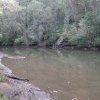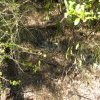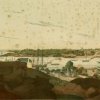1840s
Robert Pymble the elder related that members of a Koori clan periodically travel from Lane Cove River at a point near Burns Bay on the way to Cowan, ’by way of what is now known Cowan Road. They always break the journey and camp on Wright’s Hill, near the present reservoir at Pymble‘… He continued that the hill beyond the present situation is called by those campers ‘Turramurra’ or ‘Turraburra’ the word meant ‘big hill’. (‘Reminiscences of J G Edwards 1843-1927’, Evening News, July 1921)
George Angas, a wealthy Baptist philanthropist, visits the colony from Britain. He shows interest in Aborigines, especially the “singular and interesting remains of a people who are now nearly extinct”. Angas, with Police Superintendent Miles, examines in detail the “carvings in outline, cut into the surface of flat rocks … especially on the summits of the various promontories about the harbours of the coast”. He visits an Aboriginal camp near Camp Cove where “about a dozen natives of the Sydney and Broken Bay tribes were encamped”, and persuades ‘Old Queen Gooseberry’, Bungaree’s widow, to explain to him what she knew of the North Head carvings. She initially objects, saying that these places were ‘koradjee ground’ or ‘priests’ ground’ that she must not visit. After she was encouraged to row across the harbour with them in a whale boat, she “consented at the last to guide us to several spots near the North head, where she said the carvings existed in great numbers, as also impressions of hands upon the sides of high rocks”.
Birth of Mary Jane Fonseca, daughter of Esther Aiken, a descendant of Kitty. She dies in 1924.
1840
1841
1842
1843
Birth of James Ashby, son of Charlotte Ashby. Marriage of Charlotte to James Ashby. They receive a land grant at Dora Creek, (Wyee). After Charlotte’s husband dies her children are taken away and put into the Benevolent Society Institution and her land is confiscated. Charlotte is incarcerated in a psychiatric institution. The family recall that once the police found out they were Aboriginal, they moved them on, saying “She’s only a blackfella anyway”.
1844
Queen Cora Gooseberry is drawn by Charles Rodius as she camps with her family on the footpath outside The Cricketer’s Arms hotel at corner of Pitt and Market Streets Sydney. She is also known as One Eyed Poll and and Onion-head from the way she wore her hair high on her head. She survives her husband Bungaree by 20 years. She makes a living by begging outside the hotel where the publican gives her a room to sleep in. Her (known) children are ‘Miss Diana Bungaree’, Long Dick and Young Bungaree.
1845
The Catholic Archbishop of Sydney gives evidence for the reasons for decline in Aboriginal numbers, referring to “the aggressive mode of taking possession of their country which necessarily involves a vast loss of life to the native population … I have heard myself a man, educated and a large proprietor of sheep and cattle, maintain that there was no more harm in shooting a native, than in shooting a wild dog … I fear also, though I am ashamed to say it, that I have reason to believe that poison has been, in many instances, used.” (Gayle and Brookman 1975)
The Sydney Morning Herald reports the “last Aboriginal of Sydney had died, a beggar who slept outside the gates of the Legislative Assembly”. In reality there were many hundreds of survivors of the invasion.
Some white Sydney-siders take up collections to provide help to a “dying race”.
1846
The government of NSW forms a Select Committee to look into conditions of Aborigines. Rev William West Simpson, the Anglican Minister at the Lower Hawkesbury (Wiseman’s Ferry) sends the following note:
In Marramarra Creek I have found a family of half castes, the children of John Lewis or Ferdinand, a white man employed in the lime burning trade … The mother is Biddy, the sister of the blackfellow Bowen, of Pitt Water and the daughter of an aboriginal woman by an English seaman. There are seven children by this connexion, from nineteen to two years of age, living in their father’s house after the manner of the settlers of the Creek … The two lads are employed in the boat with their father, four of the younger children are yet at home, and the eldest girl is living with a man of the name of Rose, a fisherman at Marramarra Creek. (NSW Legislative Council Select Committee 1846, quoted by Richmond)
NSW Legislative Council Select Committee takes evidence from Reverend John McKenny: “The numbers (of Aboriginal people) were greatly diminished … about 5 years ago by an epidemic said to be measles which carried off a great many”. There are many reported cases of white men living with Aboriginal women and having children. (NSW Legislative Council Select Committee 1846)
The Reverend John Polding declares “I conceive that there is established in the minds of the black population a sentiment that the whites are essentially unjust … founded on the fact of the whites coming to take possession of their lands, without giving them what deemed an equivalent … to trespass upon the hunting grounds of another tribe is deemed by them a cause of war.” (NSW Legislative Council Select Committee 1846, p. 581)
1847
Reverend John Gregory states “that settlers believed the Aborigines were decreed by God to a position of innate inferiority from which the only escape was an inevitable extinction” . Threlkeld had a mission station near Lake Macquarie. He stated that the Aborigines had strayed from God’s path and as a result were doomed. (Gunson 1974)
1848
European settlement severely impacts on environment. NSW Surveyor-General Major Mitchell writes “the omission of the annual periodical burning by natives, of grass and young saplings, has already produced in the open forest lands nearest Sydney, thick forests of young trees, where formerly a man might gallop without impediment and see miles before him”. (Bennett 1969)
1849
Bowen Bungaree, Bungaree’s son, sails with other Koories to the Californian gold fields with Richard Hill because of their skill in sailing boats and in the hope to be given jobs to carry the crowds of gold seekers flocking to the Eldorado. Black Bowen is the only one to return. He speaks with ridicule about America, “That country! No wood for fire, but plenty cold wind … no good for me! No good for blackfellows!”
On his return Bowen resumes his duties as a Police Tracker and reports to police the activities of two assigned servants (convicts) who had escaped and are petty thieves on the Northern Beaches. The men are captured and sent to prison. Bowen’s reputation is now well established, for example he tracks and uses his gun to hunt the bush-ranger Casey. Bowen wear grand clothes, Farrell describes him: “He was in full rig with dress coat, his hair knotted up behind with three feathers stuck in it”. (Jacobs 2007)












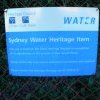

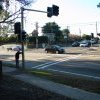
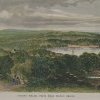
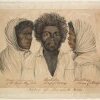
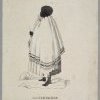
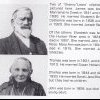
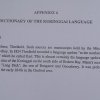
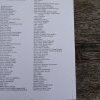

 drawn by Mikhailov, 1820, courtesy AIATSIS.thumbnail.jpg)
